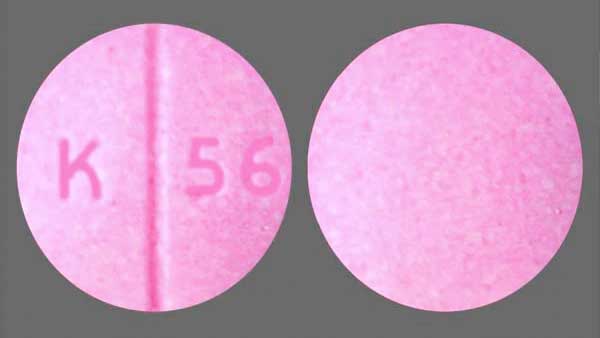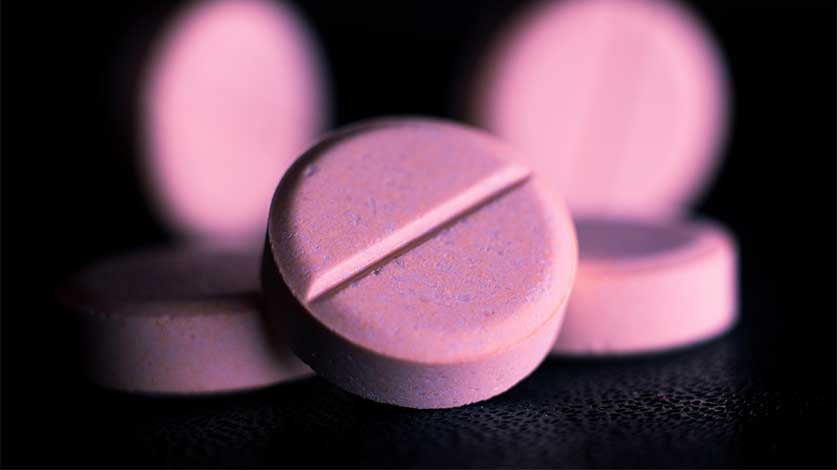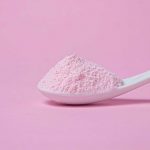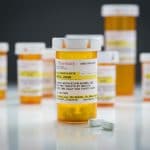Oxycodone hydrochloride is one of the most popular opioid medications. It eases moderate to severe pain by attaching to opioid receptors throughout the body.
As with other prescription drugs, the appearance of oxycodone depends on the manufacturer. One of the most popular types of oxycodone is called pink oxycodone.
Pink Oxycodone Uses
Pink oxycodone is manufactured by the pharmaceutical company KVK Tech, Inc. It contains 10 milligrams of oxycodone. It’s also an immediate-release tablet, which means its effects fade faster than the effects of extended-release oxycodone tablets.
Because its effects don’t last that long, pink oxycodone is usually not prescribed for people experiencing chronic pain or pain from long-term illnesses like cancer. Instead, it’s mainly used to treat short-term pain, such as pain following an injury or surgery.
How To Identify Pink Oxycodone
Pink oxycodone pills are pink, round, and scored. The letter K is imprinted on one side of the score, and the number 56 is imprinted on the other side of the score. That’s why the pills are sometimes called “K 56 pills.”

Pink Oxycodone K 56 Pill
Effects Of Pink Oxycodone
Along with easing pain, pink oxycodone can cause unpleasant side effects, including:
- headache
- dry mouth
- drowsiness
- stomach cramps
- constipation
- mood swings
The drug can also cause relaxation and euphoria (intense joy). That’s why some people abuse it.
Pink Oxycodone Abuse
The United States Drug Enforcement Administration (DEA) classifies pink oxycodone as a Schedule II controlled substance. That means that although it’s generally safe when used as prescribed by a medical professional, it poses a high risk of abuse.
Pink oxycodone abuse occurs when you use the drug in a manner not prescribed. For example, you might:
- use it more often than prescribed
- use higher doses than prescribed
- use it without a prescription
- mix it with other drugs
- crush the pills and snort them
All forms of pink oxycodone abuse can lead to serious side effects, overdose, and addiction.
Serious Side Effects
People who abuse pink oxycodone are much more likely to experience the drug’s common side effects. They may also experience rarer, more serious side effects, including:
- irritability
- confusion
- hallucinations (seeing, hearing, or feeling things that aren’t really there)
- sweating
- shivering
- fever
- dizziness
- nausea and vomiting
- loss of appetite
- heartbeat changes
- irregular menstruation
- erectile dysfunction (difficulty getting or keeping an erection)
- reduced sexual desire
- seizures
If you or someone you love experiences these more serious side effects seek medical advice as soon as possible.
Pink Oxycodone Overdose
Like other opioids, pink oxycodone is a central nervous system depressant. That means it slows down the functions of your central nervous system, including your breathing and heart rate.
If you use too much pink oxycodone, these functions may slow to the point of a life-threatening overdose. The most common symptoms of overdose include:
- slowed breathing (also called respiratory depression) or other breathing problems
- slowed heart rate
- low blood pressure
- weakness
- extreme drowsiness
- change in pupil size
- cold, clammy, or bluish skin
- bluish lips and/or fingernails
- nausea and vomiting
- confusion
- seizures
- loss of consciousness
If you think you or someone you know is overdosing on pink oxycodone, call 911 right away, and administer naloxone if possible.
Naloxone is a medication that’s sold under the brand name Narcan. As an opioid antagonist, it can quickly reverse the effects of an opioid overdose. It’s available at most pharmacies without a prescription.
Fentanyl-Laced Oxycodone
You face a higher risk of overdose if you mix pink oxycodone with other central nervous system depressants (such as alcohol, benzodiazepines, or other opioids) or if you buy it on the street. That’s because many opioids sold on the street are laced with fentanyl.
Fentanyl is an extremely powerful opioid pain reliever. According to the Centers for Disease Control and Prevention (CDC), it’s up to 50 times more powerful than heroin. Even very small doses can be deadly.
Opioid Addiction
People who abuse pink oxycodone face an extremely high risk of addiction. Addiction (also called substance use disorder) is a serious disease that makes you feel unable to stop using drugs. The most common symptoms are tolerance and physical dependence.
Tolerance means your body gets used to the effects of a drug. You will then need increasingly higher or more frequent doses to feel the desired effects.
Physical dependence means your body starts relying on a drug to function properly. When you stop using it, you may experience withdrawal symptoms. The most common withdrawal symptoms associated with pink oxycodone include:
- anxiety
- irritability
- sweating
- watery eyes
- runny nose
- frequent yawning
- muscle pain
- stomach pain
- nausea and vomiting
- diarrhea
Other symptoms of addiction may include mood swings, loss of motivation, a decline in personal hygiene, and loss of interest in activities once enjoyed.
When left untreated, the disease can lead to issues like damaged relationships, financial difficulties, and homelessness. It also greatly raises your risk of fatal overdose.
To learn about treatment options for pink oxycodone addiction, please reach out to Northeast Addictions Treatment Center.
Our compassionate health care providers offer a variety of evidence-based treatments, including cognitive behavioral therapy, group therapy, and medication-assisted treatment.
Continue Reading:
- Oxycodone Cold Water Extraction
- How Long Is Oxycodone In Your System?
- Snorting Oxycodone
- Smoking Oxycodone
- Can You Inject Oxycodone?
- Drug Overdose Deaths In The U.S. Reach Historic Levels
- National Prescription Drug Take Back Day
- Classes Of Controlled Substances In Massachusetts
Sources:
Centers for Disease Control and Prevention — Fentanyl Facts
Drug Enforcement Administration — Oxycodone
National Library of Medicine: MedlinePlus — Opiate and opioid withdrawal
National Library of Medicine: MedlinePlus — Oxycodone




